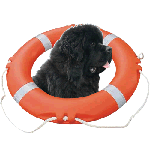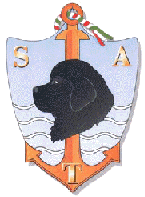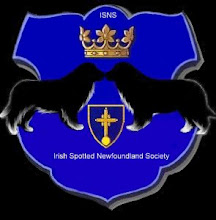Sunday, July 10, 2022
Newfoundland Joins Lifeguards At Scarborough Beach State Park
(By Drew Johnson - The Forecaster - July 5, 2022)
Five dogs took to Scarborough Beach State Park last week, but not to play fetch or go for a walk.
Beacon, a 14-month-old Newfoundland, is training to help lifeguards save lives. Two visiting dogs were there to train Beacon and the two other canines.
“(Beacon) won’t be a first responder; she’ll be a second responder,” said Park Manager Greg Wilfert. “What her job will be is to help the lifeguards bring the people back in. I have all my lifeguards working with her.”
Beacon has been working with trainers from the American Academy of Canine Water Rescue, based in Massachusetts.
It’s quite a spectacle when Beacon trots along the shore wearing her life jacket. Beachgoers stop to pet and take photos of her and ask Wilfert a lot of questions. The idea of a professionally trained water rescue dog is, quite literally, foreign.
“I had seen the groups from Italy and Croatia that use dogs as water rescue dogs,” Wilfert said. “I just thought it was another tool that could be utilized like our Jet Ski is. You don’t use it all the time, but you have it there for a purpose.”
Italy has certified 400 water rescue dogs via the Scuola Italiana Cani Da Salvataggio, or Italian School of Rescue Dogs. Two of them — Angel and Oakley — and their owners were invited to Scarborough Beach on June 30 to help train Beacon and the two other dogs, a German Shepard named Athena and a 4-month-old Newfoundland named Orso.
The latter spent the morning soaking up the sun and studying his peers.
Angel, also a Newfoundland, was the first dog from the United States to be certified in water rescue in Italy.
“That’s one of the reasons why I founded the American Academy of Canine Water Rescue,” said Maria Gray, who also owns Angel. “I want to bring their techniques and their philosophy and their methodology here to the United States.”
Over 10 people drown in the United States every day, Gray said, a statistic that doesn’t account for those who suffer severe injuries and brain damage from accidents on the water.
“It’s 100% preventable if you follow basic rules, if you swim with a buddy, if you wear a life jacket on open ocean water,” Gray said. “We strive to educate, but we also work to train these dogs to actually be able to conduct a rescue.”
Oakley, a black and white Newfoundland, also known as a Landseer, was also there to teach the dogs some new tricks. She drew quite the crowd in Scarborough Thursday, in part due to her eyewear.
“The goggles are probably the most noticeable thing,” said George Abraham, lead instructor at the American Academy of Canine Water Rescue, and Oakley’s owner. “They’re made specifically for working dogs.”
The goggles function as sunglasses but also help protect Oakley’s eyes from sand and salt water, which is often kicked up when she and Angel jump out of helicopters in the Mediterranean Sea as part of their open-water rescue training.
Beacon will not be jumping out of any helicopters on Wilfert’s watch, but she does ride on a personal watercraft.
“Beacon’s been out on the Jet Ski, she’s made simulated water rescues,” Wilfert said. “(Lifeguards) have to work with her four to five times a day on certain training aspects.”
Advertisement
Much of that includes obedience, like staying when told and walking alongside her assigned lifeguard on patrols. While those may seem like simple tricks, it’s important for water rescue dogs to instantly follow commands. Fortunately for Beacon, Oslo and Athena, they are learning from one of the best: Oakley.
“She’s traveled around the world, 99.9% of the time off-leash,” Abraham said.
Throughout the interview, and for much of Thursday morning, Oakley didn’t move in the midst of the crowded beach.
“She always keeps eye contact; if I go somewhere, she’s going to start looking,” Abraham said, taking no more than three steps across the beach. “She looked. She always knows where I’m at, she’s always waiting for her next command.”
While any dog of “sufficient size” and strength can be trained, Newfoundlands are often in a class of their own when it comes to water rescue. They have webs between their toes, use a swimming style more similar to a human’s than a doggy paddle, and have three coats of fur, “which keeps them dry even in the coldest waters.
“The Newfoundland is the only dog that can swim in Arctic waters without dying of hypothermia,” Gray said. “They’re incredible.”
Working with Angel and Oakley, Wilfert said, requires Beacon to do a lot of watching and studying. When Oakley performed a simulated rescue mission, Wilfert made sure Beacon was watching.
In the simulated mission, a lifeguard plays the role of a drowning swimmer. Another lifeguard, the first responder, swims out to help and signals back to the beach for backup. That’s when the second-responding lifeguard comes to the rescue along with a dog.
The dogs are trained to tow the lifeguards and distressed swimmers to shore by tugging on a rope attached to the floating devices lifeguards bring out to support the victim. It’s a strategy that permits one lifeguard to give their full attention to the swimmer and increases the speed of the rescue.
“The dog allows me to, much more quickly, get to a person in distress and helps me get back to a boat or the shore,” Gray said.
The dogs also help the lifeguards navigate. During Oakley’s simulation, she did not swim directly to the shore, but at a slight angle. Using their intuition, the dogs are able to find the path of least resistance, Wilfert said, accounting for the wind and waves. When it was Beacon’s turn to simulate the mission, she used the same tactic, alongside Angel as her mentor.
The session at Scarborough Beach was also a learning experience for Angel and Oakley. They usually train in the open ocean or lakes and ponds, so the experience at the beach trains them to overcome the waves crashing on the shore.
In Italy, where water rescue dogs have been trained and certified for 30 years, Gray said, dogs are responsible for saving hundreds of lives each year. In an effort to make rescue dogs more widely used, Angel and Oakley have performed demonstrations for U.S. Coast Guard bases across the country.
Meanwhile, Beacon is progressing at a fast rate, and it seems Scarborough Beach lifeguards will have a four-legged, tail-wagging companion to lean on for some time.
“Beacon’s only 14 months, going on 15 months old,” Wilfert said. “She’s very young to be at this stage, and she’s learned a lot with Angel and Oakley … that’s why they’ve been invited here to train on the beach; so that Beacon can see their dogs in action.”
Sunday, July 3, 2022
Seaman - A Newfoundland Dog Who Accompanied Lewis and Clark
(Americacomesalive.com)
"Lewis and Clark’s Corps of Discovery Expedition was commissioned by President Thomas Jefferson shortly after the Louisiana Purchase in 1803. Jefferson asked Captain Meriwether Lewis to head up a select group that partially consisted of U.S. Army volunteers; Lewis was to be aided by his good friend, Second Lieutenant William Clark. Their primary goal was to explore and map the newly acquired territory and find a practical route across an essentially unexplored part of the continent. It was a risky journey, and no one could predict how long the Corps would be gone.
The group planned to depart from St. Louis in the spring of 1804, and Seaman was thought to have been purchased by Meriwether Lewis for $20 while he was in Pittsburgh waiting for the completion of the boats that would be taken on the journey. There is no record as to why Lewis selected a Newfoundland—whether it was simply a dog that caught his attention or whether he selected Seaman because the breed is known for being smart and strong with good swimming ability.
Occasionally readers may find the Newfoundland referred to as Scannon. In 1916 Lewis’ handwriting was misinterpreted by a historian, and the dog’s name was written as Scannon. Not until 1987 was the mistake discovered. Historian Donald Jackson was at work with the material and re-examined the journals, realizing that the dog’s name was actually Seaman.
As one would expect, the Corps of Discovery participants were totally occupied finding their way through country they did not know, coping with adversity, and documenting their discoveries—both the routes taken as well as notes on flora and fauna found along the way. Seaman is mentioned only on an 'as necessary' basis – at times of crisis or when Meriwether Lewis had a little extra time and the dog’s story illustrated a point.
One of the first mentions of the dog is as Lewis and Seaman departed from Pittsburgh on August 30, 1803. Lewis writes that Seaman was skilled at catching and killing squirrels, which Lewis found excellent to eat once 'fryed.'
Once on the journey, Seaman attracted positive attention from the Shawnees who offered three beaver skins for the dog, but Lewis said no. Later Seaman also was reported as a favorite of a 'buffaloe calf' that followed them along the shore until Lewis and Seaman re-boarded the boat.
Seaman had some nights when he would wander and explore on his own, and occasionally, Lewis expressed concern in his journal entries, but each morning Seaman returned to accompany the group on the next leg of the trip.
On May 19, Lewis notes that Seaman was seriously hurt. One of the men had shot and wounded a beaver, and when Seaman went out to retrieve it, the animal bit him through the hind leg, cutting an artery. Both Lewis and Clark took extraordinary medical measures to save Seaman, and fortunately, the dog pulled through.
And only ten days later, Seaman was credited by the men with saving the expedition. During the night a buffalo bull charged through the camp. Another member of the party, Sergeant Ordway, documented in his journal that the great beast passed 'between 4 fires & within a few inches of Several men; it was Supposed if he had trod on a man it would have killed him dead. The dog flew at him which turned him from running against the lodge [in] which the officers layed, [and] he passed without doing more damage than [breaking the stalk] of a rifle & injuring one of the blunderbusses [muzzle-loading firearm] in the pirogue [type of boat used for the expedition] as he passed through.'
The occurrence had the entire camp in an uproar, with everyone up and armed. After greater wakefulness, they realized that thanks to Seaman the threat had passed.
Lewis’ journals also note that Seaman was plagued by some of the same annoyances of nature that bothered the men. Mosquitoes were everywhere: 'the mosquitos continue to infest us in such manner that we can scarcely exist…my dog even howls with the torture he experiences from them, they are almost insupportable, they are so numerous that we frequently get them in our throats as we breathe.'
Another irritation to man and beast were the barbed seeds of the foxtail. Seaman’s heavy coat, which helped him withstand the cold from swimming in icy water, made him a good target for carrying these seeds. Lewis wrote: These 'penetrate our mockersons and leather legings and give us great pain until they are removed. My poor dog suffers with them excessively, he is constantly binting and scratching himself as in a rack of pain.'
Other adventures of Seaman are described here and there in the journals, but for almost a year (August 1805 to July 1806), Seaman is not mentioned. Then in July of 1806 there is a journal entry noting that a creek was being named in Seaman’s honor. This left historians with the impression that Seaman was still alive. Most also feel that if anything had happened to him, the event would have been recorded.
After the trip there is no mention of Seaman as part of Lewis’ life, but author and historian James J. Holmberg has done some additional sleuthing to determine what happened to the dog.
Eventually Holmberg came upon some information in a book published in 1814 that leads him to believe that Seaman survived the trip and continued to make his life with Meriwether Lewis. The book that led Holmberg to this conclusion was a book of epitaphs and inscriptions of the day, recorded by a clergyman and educator named Timothy Alden.
According to Holcomb, Entry 916 of American Epitaphs and Inscriptions lists an inscription that was on a dog collar that had been donated to a museum in Alexandria, Virginia. The inscription read:
'The greatest traveler of my species. The name is SEAMAN, the dog of captain Meriwether Lewis whom I accompanied to the Pacifick ocean through the interior of the continent of North America.'
The additional details noted by Alden had to do with the period following Meriwether Lewis’ untimely death in 1809. Lewis had suffered from depression for many years but whether the death was suicide — as most historians feel — or murder is still an ongoing discussion.
Alden’s note following the inscription was this (exactly as it was written): 'The fidelity and attachment of this animal were remarkable. After the melancholy exit of gov. Lewis, his dog would not depart for a moment from his lifeless remains; and when they were deposited in the earth no gentle means could draw him from the spot of interment. He refused to take every kind of food, which was offered him, and actually pined away and died with grief upon his master’s grave.'
Unfortunately the collar cannot be found. The museum suffered a fire in 1871 when many artifacts were lost. The ledgers from that period still exist but Holmberg notes that while they did not mention the donation of a dog collar, they also appeared to be generally incomplete.
Despite this, Holmberg’s discovery of the information in Alden’s book does add an interesting possibility to what may have happened to Seaman."
Subscribe to:
Posts (Atom)

















































